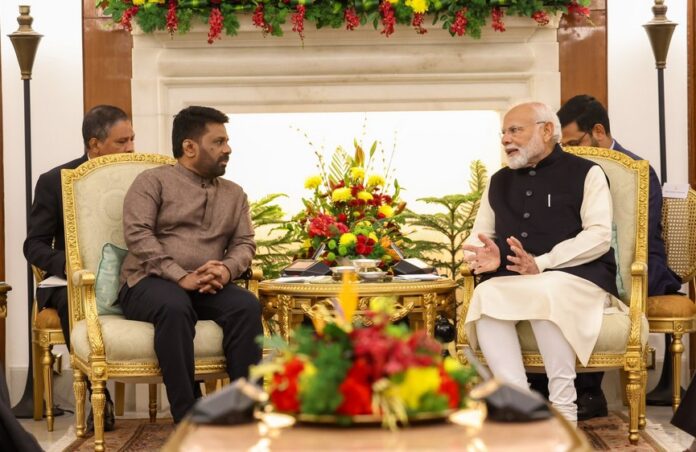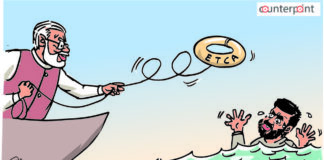By Kassapa
This week, Sri Lanka will host Indian Prime Minister Narendra Modi who is on a three-day state visit. Modi has been in office since 2014 having won three consecutive general elections. This is his fourth visit to the island- and probably the most significant.
Modi last visited Sri Lanka in June 2019 at the tail end of the Maithripala Sirisena Presidency. Notably, he did not visit when either Gotabaya Rajapaksa was President (although a significant period of that time was under the cloud of the Covid pandemic). Neither did he travel to Sri Lanka when Ranil Wickremesinghe was President, despite a longstanding invitation.
Modi is a divisive figure in India just as much as Mahinda Rajapaksa is in Sri Lanka. Rajapaksa is venerated for his successful effort to annihilate the Liberation Tigers of Tamil Eelam (LTTE) and eliminate terrorism but is equally reviled for the subsequent collapse of the economy, dereliction of law and order, rampant corruption and cronyism that emerged during his and his brother Gotabaya’s terms of office. Similarly, Modi is admired for his efforts to make India not only a regional power but also a global economic powerhouse but strongly despised for his blatant advocacy of Hindu nationalism at the expense of other religions in what is an established secular state.
Still, whatever his vision, Narendra Modi is an astute politician. At seventy-four years of age, five years younger than Mahinda Rajapaksa and two years younger than Ranil Wickremesinghe, he is physically fit, works around the clock, travels extensively and shows no signs of giving up his stranglehold on power until his dream of creating ‘Bharat’ out of India is realised. He is arguably the smartest Indian leader since Indira Gandhi.
That is why his government invited Anura Kumara Dissanayake to visit New Delhi last year, months before the presidential election. It was an unprecedented move because, at the time, Dissanayake was merely an opposition parliamentarian and a party leader, heading the Jathika Jana Balavegaya (JJB).
Indian intelligence services and their men on the ground in Colombo advised, correctly, that Dissanayake was the likeliest candidate to win the presidential election that was looming. In any event, if any of the other two main contenders, Ranil Wickremesinghe and Sajith Premadasa, emerged victorious New Delhi wouldn’t have a problem. They would both acquiesce easily to New Delhi’s requests, given the dire straits of the Sri Lankan economy. Dissanayake, they were not so certain of.
For all the wallpapering and rebranding that has been done, the JJB is driven by its main constituent, the Janatha Vimukthi Peramuna (JVP). The JVP has historically been rabidly anti-Indian. The famous ‘five classes’ of indoctrination carried out by its founder Rohana Wijeweera included one on ‘Indian expansionism’. The JVP was also at the forefront of opposing the Indo-Lanka Accord of 1987, reached between then President J.R. Jayewardene and then Indian Prime Minister Rajiv Gandhi. They subsequently used the anti-Indian sentiment the Accord generated as a rallying cry for their second insurrection in 1988 and 1989. So, being anti-Indian was very much in the DNA of the JVP.
This is precisely why New Delhi in general and Modi in particular have gone out of their way to woo and win over Dissanayake. They are aware that Dissanayake’s party also has inextricable links to China, through the Communist Party of China. China being India’s long-standing rival in the region, that would have made them even more anxious about Dissanayake’s ascension to power in Sri Lanka.
Where India has succeeded is in exploiting Sri Lanka’s current economic vulnerability. When the country was in the throes of an economic crisis in 2022, it was India which provided a lifeline with financial grants. On the contrary, when negotiations were conducted to restructure our debts, China was reluctant to compromise. As a result, as President-elect, Dissanayake had little choice but to work with Modi. To his credit, Dissanayake has done just that, despite the ideological distress this must be generating.
There have been irritants in this journey. Main among them is the ‘Adani’ factor. This is about the proposed 442-million-dollar wind power project in North Sri Lanka which has followed a ‘on-off’ trajectory. The agreement to set up the project was considered a ‘done deal’ under the Wickremesinghe government when the newly elected Dissanayake regime said it will be reviewed. On the heels of that came the news that Adani was withdrawing. Colombo has added to the confusion by stating that if the cost of a unit of power was kept low, it would consider going ahead with the project.
Billionaire Gautam Adani is one of Modi’s staunchest allies and there is no doubt the Adani project will be mentioned during Modi’s conversations with Dissanayake. As for Dissanayake, he has categorically stated his position: if the cost is not kept low, the project will not go ahead. Of course, Dissanayake has to appease not only Modi but also his own JVP cadres who are wondering why their leader is pursuing Wickremesinghe’s policies to keep the economy afloat. Whether Modi understands these political nuances, and even if he does, whether he is prepared to overlook this in favour of a more sustained relationship with Dissanayake remains to be seen.
Indeed, India’s southern states are the engines that drive its economy now. Their close proximity to Sri Lanka means that they can access resources more easily from Sri Lanka than from the northern part of their own country. This therefore presents a unique opportunity for Sri Lanka to piggy-back on India’s economic surge to gain some benefits for itself.
Colombo is aware of this. However, it’s government, with its historical anti-Indian credentials has to now sell this to not only its own cadres but also to sceptical voters who have always thought of India as the big, bad bully.
To do so, Anura Kumara Dissanayake needs Narendra Modi’s support economically as much as Modi needs Dissanayake’s support politically, just to ensure that there is no rabble rousing in his southern backyard. This is the conundrum that both leaders confront.



 Logging you in...
Logging you in... Loading IntenseDebate Comments...
Loading IntenseDebate Comments...

